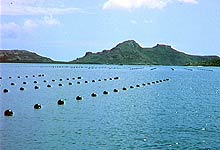|
Book a live visit via videoconference to the Great Barrier Reef with the Great Barrier Reef Education Team.
For www support – email: education@reefHQ.org.au
Prior to visiting the Great Barrier Reef ‘virtually’, read picture books about the reef, view photos or suitable videos.
Students mime activities undertaken on the Great Barrier Reef
Photograph these or ask students to draw them. Place photographs/drawings on to a painted mural of the Great Barrier Reef.
Turn your classroom into the Great Barrier Reef.
- Learn more about the Reef by visiting http://www.gbrmpa.gov.au.
- Decorate the entire classroom to look like the habitat of a reef community as much as possible. Don’t forget signs, facilities, special places, as well as the corals, plants and animals. Consider the work and recreational activities undertaken on and in the waters of the Great Barrier Reef.
- You may like to make up an information sheet about the Reef to tell other classes in you school about it. They may like to visit your “ Great Barrier Reef”.
Establish students’ prior knowledge by asking questions such as:
- What things would you expect to find in the Great Barrier Reef?
- How can you tell if something is natural or human-made?
- Who works there?
- Who uses the Great Barrier Reef? and
- What do they use it for?
|
Observing, Collecting, Recording
Whilst visiting the Great Barrier Reef virtually via videoconference or viewing a video, undertake the following activities:
- Talk about the natural and built features of the Great Barrier Reef;
- Ask questions about the Reef and its surroundings;
- Identify and describe objects in the Reef and on the Reef;
- Record information about the Reef, eg. its colours, plants within it, animals and different areas seen;
- Identify whether the Reef is there naturally or whether it has been “planted”; and
- Record understandings about the resources the Reef provides to meet our needs.
|

Cage buoys of the pearl shell culture
farm at Cape York |
They can also observe, collect and record a range of things. For example:
With the help of adults, students identify human-made and natural features within the Great Barrier Reef, or make a set of cards and play “Spot the Reef features”. Using a number of cards with Great Barrier Reef features on them, ask students to say which are human-made or natural features and why, and which features are resources we need and want.
See Resource 1.2
n a Public Aquarium, Marine Discovery Centre or videoconference inclusive of the Great Barrier Reef, students can do the following:
- Observe, touch specimens, and feel reef corals (Note you will only be able to touch specimens of hard coral);
- Locate and describe soft and hard corals, their tentacles and polyps;
- Locate and identify big fish eg. groupers, trevally, and wrasse;
- Locate and identify sea turtles, sharks and rays;
- Locate brightly coloured reef fish;
- Locate reef animals with “shells”;
- Locate and describe jellyfish and sponges;
- Locate information, signs, cultural heritage sites; and
- Locate and identify Great Barrier Reef flora for example seagrass.
Collection
Photograph structures and features for later identification. Tape sounds for classification.
Collect illustrations, pamphlets or fact sheets about features and uses of the Great Barrier Reef. |

Anemonefish swimming amongst Sea
anemones in a Great Barrier Reef
Aquarium display tank |
| |
|
|
The Great Barrier Reef Marine Park is home to:
- 2904 coral reefs built from359 species of hard coral;
- Six of the world’s seven species of marine turtles;
- Over 2200 species of native plants;
- Over 1500 species of fish; and
- Over 200 species of birds.
Recording: Construct a checklist or use Resource 1.3 for students to count and record the number of certain features and uses.
Note: If this “visit” or video isn’t possible, download the photofile at www.gbrmpa.gov.au for images to support this activity. |
See Resource 1.3
Ask students to decide what purpose each feature or use serves.
|
File the checklist of words and symbols as evidence of students’ skill in applying the concepts “natural” and “human-made”. |
|